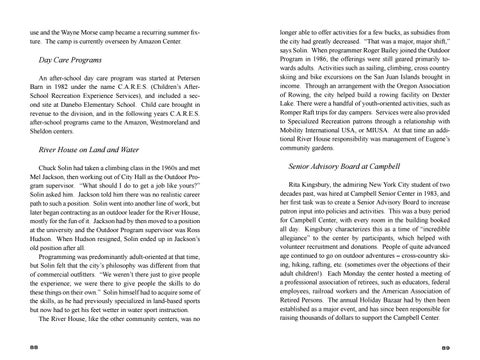use and the Wayne Morse camp became a recurring summer fixture. The camp is currently overseen by Amazon Center.
Day Care Programs An after-school day care program was started at Petersen Barn in 1982 under the name C.A.R.E.S. (Children’s AfterSchool Recreation Experience Services), and included a second site at Danebo Elementary School. Child care brought in revenue to the division, and in the following years C.A.R.E.S. after-school programs came to the Amazon, Westmoreland and Sheldon centers.
River House on Land and Water Chuck Solin had taken a climbing class in the 1960s and met Mel Jackson, then working out of City Hall as the Outdoor Program supervisor. “What should I do to get a job like yours?” Solin asked him. Jackson told him there was no realistic career path to such a position. Solin went into another line of work, but later began contracting as an outdoor leader for the River House, mostly for the fun of it. Jackson had by then moved to a position at the university and the Outdoor Program supervisor was Ross Hudson. When Hudson resigned, Solin ended up in Jackson’s old position after all. Programming was predominantly adult-oriented at that time, but Solin felt that the city’s philosophy was different from that of commercial outfitters. “We weren’t there just to give people the experience; we were there to give people the skills to do these things on their own.” Solin himself had to acquire some of the skills, as he had previously specialized in land-based sports but now had to get his feet wetter in water sport instruction. The River House, like the other community centers, was no
88
longer able to offer activities for a few bucks, as subsidies from the city had greatly decreased. “That was a major, major shift,” says Solin. When programmer Roger Bailey joined the Outdoor Program in 1986, the offerings were still geared primarily towards adults. Activities such as sailing, climbing, cross country skiing and bike excursions on the San Juan Islands brought in income. Through an arrangement with the Oregon Association of Rowing, the city helped build a rowing facility on Dexter Lake. There were a handful of youth-oriented activities, such as Romper Raft trips for day campers. Services were also provided to Specialized Recreation patrons through a relationship with Mobility International USA, or MIUSA. At that time an additional River House responsibility was management of Eugene’s community gardens.
Senior Advisory Board at Campbell Rita Kingsbury, the admiring New York City student of two decades past, was hired at Campbell Senior Center in 1983, and her first task was to create a Senior Advisory Board to increase patron input into policies and activities. This was a busy period for Campbell Center, with every room in the building booked all day. Kingsbury characterizes this as a time of “incredible allegiance” to the center by participants, which helped with volunteer recruitment and donations. People of quite advanced age continued to go on outdoor adventures – cross-country skiing, hiking, rafting, etc. (sometimes over the objections of their adult children!). Each Monday the center hosted a meeting of a professional association of retirees, such as educators, federal employees, railroad workers and the American Association of Retired Persons. The annual Holiday Bazaar had by then been established as a major event, and has since been responsible for raising thousands of dollars to support the Campbell Center.
89
